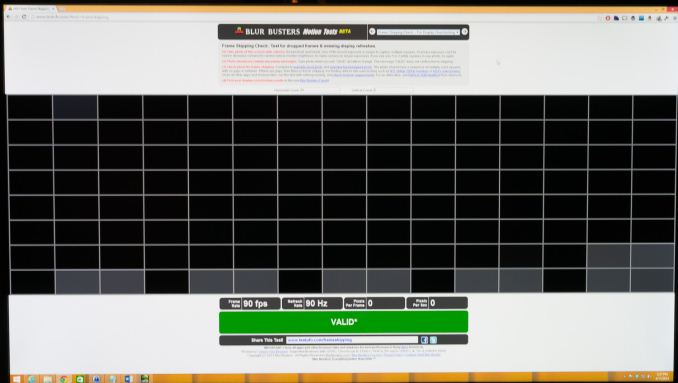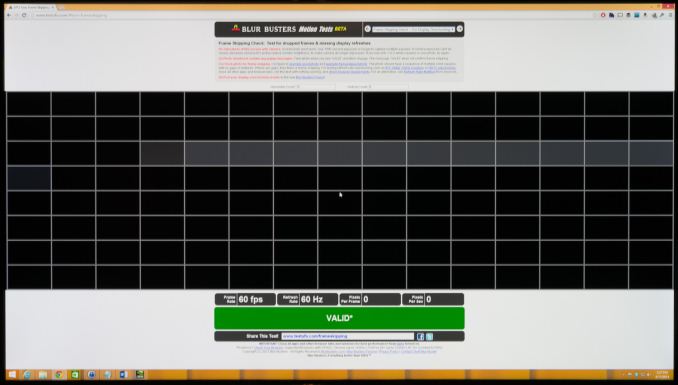QNIX QX2710 LED DPmulti True10 Review
by Chris Heinonen on April 11, 2014 6:00 AM EST_678x452.jpg)
The best thing to happen to the computer monitor marketplace has been the introduction of inexpensive QuadHD displays from South Korea. At a time when a $700 monitor was considered cheap in the United States, these were available on Ebay for around $300 and utilized the same panel as more expensive offerings, though often with a lower grade panel. The introduction of these displays forced mainstream vendors in the USA to introduce more affordable models, and saw other vendors introduce more affordable products as well.
As good as this introduction has been for consumers, I always held back from recommending the displays to most people. One reason is that as an imported product that lacks a US distributor, there was very little warranty associated with them. If you received a model that had issues from a seller on Ebay, the service or replacement options you could expect were really up in the air.
Second, there was no real testing being done on them. A review sample of a foreign, imported product was impossible to get, and just buying them to test isn’t feasible. Now I finally have been offered one of these displays to test, the QNIX QX2710 LED DPmulti True10 (henceforth called the QNIX in this review). With an updated 10-bit panel and a DisplayPort input, it offers more spec-wise than the previous models. Instead of being limited to a DVI input, it also includes DSub, DisplayPort, and HDMI inputs. The panel is a 10-bit model which it accomplishes by being 8-bit with A-FRC to simulate the last two bits. Taking full advantage of a 10-bit panel is hard to do and is usually limited to just a few applications, but being true 8-bit is important.
There is an on-screen menu system that offers adjustments for Brightness and Contrast, color temperature, and a dynamic contrast mode. Enabling the Dynamic Contrast mode disables the Brightness and Contrast controls, while also setting the light output to a retina-searing level. Navigating the menu system is pretty easy overall, though not at the level of the best displays.
There is a pair of 5W speakers built into the rear of the display and they sound like most speakers on the rear of a monitor. Sound is muffled and they’ll work in a pinch, but I wouldn’t want to use them on a daily basis. One semi-interesting feature is that the QNIX can accept a 4K input and then it scales it to 2560x1440. I don’t see a reason to do this with a PC, but with a video device (i.e. a future 4K Blu-ray player, or a video game system) where your output choices are limited to 4K or 1080p, the downscaled 4K image could look better on the QNIX than upscaled 1080p.
The specs suggest that the QNIX can be overclocked to 120Hz by using a custom resolution setting for the video card, but I am unable to make it work in any configurations that I've tried (DisplayPort or DVI, AMD or NVIDIA cards). Going to 110Hz worked fine, but higher settings did not for me. It might be a panel lottery, where some work at 120Hz and some do not, but I wouldn’t assume you will get 120 Hz to work for certain. Still, pushing beyond 60Hz is at least possible.
Update: Commenters pointed out that the QNIX "overclocks" by dropping frames. To test this I used the QNIX on TestUFO.com at both 90Hz and 60Hz and took 1/5 second exposures of the Frame Skipping Check. Below you can see screenshots showing that at 90Hz, the QNIX is simply dropping frames instead of creating extra frames. At 110Hz I began to get sparkles on the screen, obviously pushing the limits of what the panel can do. Because of this, I'd discount any overclocking mentions from the QNIX as it isn't a true higher referesh rate panel.
The monitor stand offers only a tilt adjustment, with no height, pivot or swivel. A nice design cue is the inputs being on the side of the monitor and not on the bottom. Placing them on the bottom makes hooking things up hard and I wish fewer companies would do it, particularly on budget models with no height adjustment.
| QNIX QX2710 LED DPmulti True10 | |
| Video Inputs | HDMI 1.4a, DisplayPort, DVI, Dsub |
| Panel Type | AHVA |
| Pixel Pitch | 0.231mm |
| Colors | 1.07 Billion |
| Brightness | 350 cd/m2 |
| Contrast Ratio | 1000:1 |
| Response Time | 4ms GtG |
| Viewable Size | 27" |
| Resolution | 2560x1440 |
| Viewing Angle (H/V) | 178 / 178 |
| Backlight | LED |
| Power Consumption (operation) | 46 W |
| Power Consumption (standby) | 0.5 W |
| Screen Treatment | Anti-Glare |
| Height-Adjustable | No |
| Tilt | Yes |
| Pivot | No |
| Swivel | No |
| VESA Wall Mounting | Yes, 100mm VESA |
| Dimensions w/ Base (WxHxD) | 25 3/8" x 18 1/2" x 6 3/4" |
| Weight | 10.2 lbs. |
| Additional Features | 3.5mm stereo in, 3.5mm stereo out, 2x5W speakers |
| Limited Warranty | 1 year |
| Accessories | 3.5mm audio cable, DVI cable, power adapter |
| Price | Around $365 via eBay |


_thumb.jpg)
_thumb.jpg)
_thumb.jpg)
_thumb.jpg)
_thumb.jpg)
_thumb.jpg)
_thumb.jpg)
_thumb.jpg)
_thumb.jpg)
_thumb.jpg)
_thumb.jpg)
_thumb.jpg)










85 Comments
View All Comments
pierrot - Sunday, April 13, 2014 - link
Aw man, thanks for the reply though!Badelhas - Monday, April 14, 2014 - link
I have a QNIX QX2710 (normal one, with dual DVI only connection) and it dosent skip any frames at 120Mhz, I also did the test myself. I totally recommend it for gaming.I think AnandTech should not be cheap and spend 300 bucks and review that one. The one´s with multiple connections dont OC well.
Badelhas - Monday, April 14, 2014 - link
Please check this forum http://www.overclock.net/t/1384767/official-the-qn...eikast - Monday, April 14, 2014 - link
I am extremely disappointed due to this article.First of all the korean monitors (eBay) are not meant for professional usage. They're meant for gamers who want a reliable 2560x1440 monitor.
Second of all, you don't purchase the multi input version for gaming. They're horrible at overclocking and have more input lag. The version that only comes with one input (dual DVI) is what should be purchased. I paid $300 for my Xstar (same panel) with single dual DVI back in October. I had zero dead pixels, minimal lightbleeding and am able to OC it to 96 Hz without frame skips.
I love Anandtech because usually when i come here to see reviews I see good reviews from people who do their research. I made an account just so that I could post this comment.
If you are thinking about purchasing a korean monitor be sure to check out this link.
http://www.overclock.net/t/1384767/official-the-qn...
Much more useful than this article.
By the way, who the hell OCs a monitor to 110 Hz without trying other frequencies?
You start in increments and then you up the refresh rate.
milkod2001 - Monday, April 14, 2014 - link
im a bit confused with AHVA panel. Is it something new? Is it better then IPS/PLS?I wouldn't mind to pay 50xtra for proper stand with all tilt/shift options something like Dell has and another 50xtra for factory calibrated screen. Pity none of these cheapos have this options. If I'm mistaken plz post a link.
vgu - Tuesday, April 15, 2014 - link
I think the reason that this screen isn't capable of overclocking is because it has lots of processing in order to use DP and the menu system.I own the Qnix QX2710 with Dual Link DVI input only, and it overclocks to 120hz without a hitch. Used the same test as author to verify results.
However, I agree about the colors looking washed out compared to my Dell Ultrasharp.
yasamoka - Tuesday, April 15, 2014 - link
Use a color profile. At 120Hz there is quite the gamma shift.lang15 - Tuesday, April 15, 2014 - link
You picked one of the versions that does not overclock. The single input models (DVI-D only) CAN overclock easily. Is there anyway you can update the article concerning overclocking using one of these models? Any of these models that have more than one input will not overclock.okashira - Tuesday, April 15, 2014 - link
Not to mention has inferior contrast, colors and input lag.The "regular" QX2710 and DP2710LED are some of the best monitors on the market, period. They offer a combo of features that NO other monitors offer at ANY price point:
amazing colors
Good contrast for IPS type display
zero input lag
overclockable
great view angle
non-pwm dimming
Scannall - Wednesday, April 16, 2014 - link
I purchased a Qnix monitor a couple of years ago now. It was $285 delivered. And it has been great. I guess I won the panel lottery or something as there are no dead pixels, minimal backlight bleed and the color is uniform across the screen. It just has the Dual DVI input, which I don't mind but others may find bothersome.There is some element of risk buying these I suppose. With Apple or Dell, you know you will get prompt service or replacement if you're unhappy. But saving $700 made it a gamble I was willing to make.